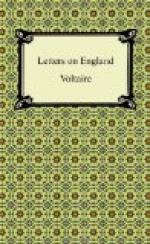But all these wonders are merely but the opening of his discoveries. He found out the secret to see the vibrations or fits of light which come and go incessantly, and which either transmit light or reflect it, according to the density of the parts they meet with. He has presumed to calculate the density of the particles of air necessary between two glasses, the one flat, the other convex on one side, set one upon the other, in order to operate such a transmission or reflection, or to form such and such a colour.
From all these combinations he discovers the proportion in which light acts on bodies and bodies act on light.
He saw light so perfectly, that he has determined to what degree of perfection the art of increasing it, and of assisting our eyes by telescopes, can be carried.
Descartes, from a noble confidence that was very excusable, considering how strongly he was fired at the first discoveries he made in an art which he almost first found out; Descartes, I say, hoped to discover in the stars, by the assistance of telescopes, objects as small as those we discern upon the earth.
But Sir Isaac has shown that dioptric telescopes cannot be brought to a greater perfection, because of that refraction, and of that very refrangibility, which at the same time that they bring objects nearer to us, scatter too much the elementary rays. He has calculated in these glasses the proportion of the scattering of the red and of the blue rays; and proceeding so far as to demonstrate things which were not supposed even to exist, he examines the inequalities which arise from the shape or figure of the glass, and that which arises from the refrangibility. He finds that the object glass of the telescope being convex on one side and flat on the other, in case the flat side be turned towards the object, the error which arises from the construction and position of the glass is above five thousand times less than the error which arises from the refrangibility; and, therefore, that the shape or figure of the glasses is not the cause why telescopes cannot be carried to a greater perfection, but arises wholly from the nature of light.
For this reason he invented a telescope, which discovers objects by reflection, and not by refraction. Telescopes of this new kind are very hard to make, and their use is not easy; but, according to the English, a reflective telescope of but five feet has the same effect as another of a hundred feet in length.
LETTER XVII.—ON INFINITES IN GEOMETRY, AND SIR ISAAC NEWTON’S CHRONOLOGY
The labyrinth and abyss of infinity is also a new course Sir Isaac Newton has gone through, and we are obliged to him for the clue, by whose assistance we are enabled to trace its various windings.
Descartes got the start of him also in this astonishing invention. He advanced with mighty steps in his geometry, and was arrived at the very borders of infinity, but went no farther. Dr. Wallis, about the middle of the last century, was the first who reduced a fraction by a perpetual division to an infinite series.




